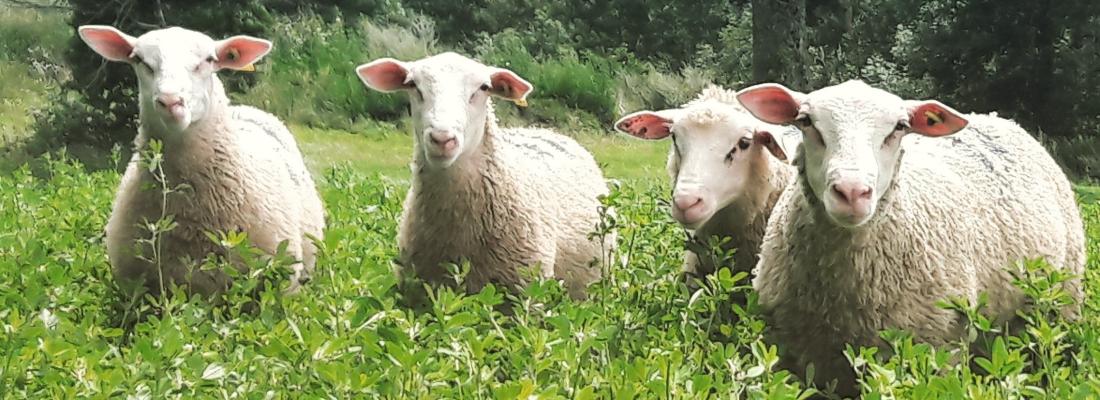Agroecology Reading time 7 min
AI knows if animals have eaten grass but not for how long: the example of lamb meat
Two artificial intelligence methods (decision trees and random forests) were tested to authenticate grass-fed lamb meat. This work identified the most relevant indicators (biomarkers) and defined a procedure that can be used in the field.
Published on 11 September 2025

Today, authenticating the origin of meat (for example, proving that it is indeed from the species stated or that the animal was raised in accordance with certain practices) is a major challenge for food safety, ethics and consumer confidence. Biological markers or biomarkers1 have therefore been proposed for the purpose of authenticating the origin of meat. But how can we identify the most relevant ones? Which ones should be combined and how? How can we define their threshold value in order to authenticate meat reliably?
This study aimed to evaluate the effectiveness of two types of machine learning algorithms2, decision trees (DT)3 and random forest (RF)4, in authenticating the method of animal husbandry (pasture or sheepfold) based on certain variables identified as potentially interesting (capable of discriminating between the two methods of husbandry).
Researchers from the Herbivores and Pegase joint research units set up an experiment at the Herbipôle EU with lambs raised either entirely in sheepfolds or in sheepfolds and then put out to alfalfa pasture for 21, 42 or 63 days before slaughter. Nineteen variables were measured on different tissues accessible at the slaughterhouse (perirenal fat) or at the point of sale (back fat, longissimus dorsi muscle).
The researchers then applied the two methods, AD and RF, to attempt to authenticate the origin of the meat (grass-fed vs. barn-fed) based on the values of these variables. The algorithms were able to distinguish between carcasses from grass-fed lambs and those from lambs raised in stalls with an accuracy of up to 95% of lambs correctly classified. Of the 19 variables, two stood out clearly: the scatol and carotenoid pigment content of perirenal fat.
Other variables that are easy to obtain through quick and inexpensive optical measurement, such as the colour of perirenal fat, also give good results (90% of lambs correctly classified); they have the advantage of being measurable on the slaughter line. The model designed for use at the point of sale, based on the colorimetric characteristics of backfat and muscle, achieved 85% accuracy. None of these three methods made it possible to distinguish between grazing durations for the batches concerned. To do so, the researchers believe that the analyses would need to be extended to other types of variables, such as the fatty acid composition of meat lipids, for example.
As this is the first study to use AI to authenticate the origin of meat, the threshold values for classification decisions will probably need to be refined based on a larger amount of data and more varied feeding practices. Nevertheless, these results open up prospects for the widespread application of AI for the purpose of authenticating farming practices.
This work shows that AI can be used to effectively select relevant biomarkers for authenticating grass-fed meat. This innovative approach is effective and promising. These tools could become invaluable, both in the laboratory and in the field, for increasing transparency regarding the origin of meat.
1 Biomarkers: these are measurable biological characteristics (such as chemical composition or colour) that differ depending on the type of meat or how the animal was raised.
2 Machine learning algorithm: a set of rules or processes used by AI to perform tasks, most often to discover new information and data patterns, or to predict output values from a set of input variables.
3 Decision tree (DT): this is a model that resembles a flowchart. It starts with an initial question and then follows branches based on the answers (yes/no) to new questions until a final decision is reached. It can be seen as a series of ‘if... then...’ rules that lead to a prediction.
4 Random Forest (RF): this is a set of several decision trees. Rather than relying on a single tree (which can sometimes be too specific), several are constructed, each trained on a random sample of the data. The predictions of these trees are then combined by majority vote to give the final prediction. This approach provides a more robust and accurate model, but one that is less easily interpretable than decision trees. This is why both methods were used simultaneously.
References: Rey-Cadilhac, L. ; Prache, S., 2025. Application of machine learning for optimizing biomarker combinations and guiding decisions on meat authentication. Meat Science, 227, 109852. https://doi.org/10.1016/j.meatsci.2025.109852
